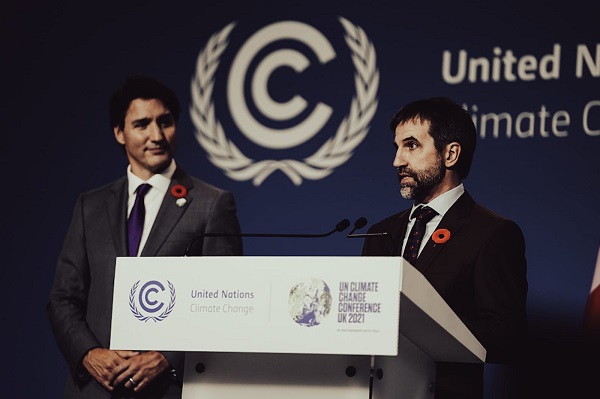Opinion
PBO Report Reveals Trudeau’s Carbon Tax Crushes Middle-Class Canadians

PBO Report Exposes Trudeau’s Carbon Tax as a Middle-Class Burden, With Net Economic Losses, Crushed Job Prospects, and Hollow Rebates
In a bombshell report dated October 10, 2024, the Parliamentary Budget Officer (PBO) exposes the cold reality of Trudeau’s carbon tax policy: it’s making life harder for middle-class Canadians. While the Prime Minister continues to tout the virtues of his climate plan, the PBO’s findings show that far from protecting the environment, the federal fuel charge is crippling Canadian families—especially those in the middle income brackets.
Let’s be clear: Trudeau’s carbon tax isn’t just a simple “polluter pays” system. According to the PBO’s distributional analysis of the federal fuel charge, average Canadian households will face substantial net economic costs by 2030, despite government-issued rebates. Trudeau loves to parade the fact that Canadians get rebates through the Canada Carbon Rebate (CCR), but the numbers tell a different story when you dig into the real economic impact.
The Middle-Class Burden
For middle-class Canadians, the so-called “climate action” of the Trudeau government comes with serious consequences. By 2030-31, the carbon price will hit $170 per tonne, with devastating effects on household incomes. Even though rebates are supposed to offset the pain, the PBO’s analysis shows that once you factor in the economic fallout—job losses, reduced wages, and weaker investments—middle-class families end up worse off.
For example, in Ontario, a province Trudeau regularly visits to promote his policies, middle-income households will face steep costs. According to the PBO, households in the third quintile (middle income) will see $588 in net costs—and that’s just after factoring in rebates. When you look at the combined hit from job losses and reduced income, the overall financial burden for middle-class families grows even larger.
In Saskatchewan, things are even more dire. The average household in the third income quintile will suffer from a $1,205 net loss by 2030-31. For working families who depend on stable employment in energy, agriculture, and manufacturing, this tax punishes them more than it rewards them.
Trudeau’s Rebate Shell Game
Trudeau’s government spins the carbon rebate as some kind of economic miracle, suggesting families get back more than they pay. But as the PBO’s report shows, this claim is little more than political smoke and mirrors. The rebates might look good on paper for the lowest-income Canadians, but for everyone else—especially middle-income earners—it’s a losing game.
Even with rebates factored in, the economic damage of Trudeau’s carbon tax results in net losses for most families. By 2030, the federal fuel charge will contribute to an overall reduction of 0.6% in real GDP across the backstop provinces, which excludes Quebec and British Columbia. Middle-class families are stuck dealing with reduced employment opportunities, lower investment incomes, and weaker wage growth—all while Trudeau’s elite friends and the liberal establishment pat themselves on the back for “going green”.
Crushing Investments and Jobs
What Trudeau doesn’t want you to know is that this tax doesn’t just hurt family finances. It’s killing jobs. The PBO report shows that by 2030, the carbon tax will reduce capital income—that’s the money people earn from investments—by as much as 2.4% in provinces like Alberta. Worse, it will slash labor income—the wages people depend on—by over 1.4% in places like Saskatchewan. That’s devastating for middle-income earners whose livelihoods depend on industries targeted by the Liberals’ climate agenda.
While low-income Canadians might see minimal gains from Trudeau’s rebates, middle-class families face the harsh reality of stagnant wages, diminished savings, and a lack of economic opportunity. Trudeau’s tax isn’t just a burden on polluters, it’s a punishment for working Canadians trying to get by.
A Failed Experiment – Just Look at British Columbia
If you want to see where Trudeau’s carbon tax will lead, just look at British Columbia. They’ve had a carbon tax since 2008, and it hasn’t stopped a single wildfire, flood, or heat dome. Did that carbon tax prevent the devastating atmospheric river? Not a chance. This so-called climate solution has done nothing to shield British Columbians from environmental disasters.
Even worse, while the federal government has been collecting billions in carbon tax revenue, they’ve neglected to address the fuel buildup in forests around places like Jasper. For years, experts have warned about the dangers, and yet not a dime of that tax money was spent on controlled burns or preventive measures. The result? Our beautiful Jasper National Park was left to burn. Trudeau and his government couldn’t save our park, they couldn’t save our forests, and they certainly couldn’t save Jasper.
A Sacrifice for Nothing
My fellow Canadians, governments have been trying to control the weather since the dawn of time. Ancient civilizations sacrificed animals to the gods, hoping for good weather. Today, the sacrifice is your money. Yesterday, it was a goat to Zeus; today, it’s a carbon tax to Trudeau. In the end, it’s just another way for the government to take from you, promising it will fix things it simply cannot control.
But here’s the truth: this tax won’t change the climate, won’t stop the floods, and certainly won’t bring back our forests. The only thing it’s doing is draining your household to feed a bloated government. The PBO report is clear: Trudeau’s carbon tax is hurting middle-class families while delivering nothing in return.
Subscribe to The Opposition with Dan Knight . For the full experience, upgrade your subscription.
International
LOCKED AND LOADED: Trump threatens U.S. response if Iran slaughters protesters

President Trump warned Friday that the United States stands ready to act if Iran’s regime escalates its crackdown on protesters, saying America would “come to their rescue” should peaceful demonstrators be violently killed as unrest spreads across the country. Writing on Truth Social, Trump said, “If Iran shoots and violently kills peaceful protesters, which is their custom, the United States of America will come to their rescue,” adding bluntly, “We are locked and loaded and ready to go.” His comments came as clashes between protesters and security forces erupted in multiple Iranian cities, leaving at least six people dead — the first confirmed fatalities since the latest wave of unrest intensified.
The demonstrations began as economic protests, driven by soaring prices, inflation, and a collapsing currency after years of sanctions tied to Iran’s nuclear program, but have quickly taken on a political edge. Shopkeepers in Tehran reportedly shut their doors in protest over economic stagnation, with similar actions and street demonstrations spreading into at least 15 cities, largely concentrated in western Iran. Iranian state media acknowledged deadly clashes in Lordegan and Azna, while state television reported that a member of Iran’s security forces was killed during unrest in Kouhdasht.
Tehran’s leadership responded sharply to Trump’s warning. Ali Larijani, head of Iran’s top security body, reportedly cautioned that U.S. involvement would “destabilize the entire region” and urged Trump to be “mindful of their soldiers’ safety.” Ali Shamkhani, an adviser to Supreme Leader Ali Khamenei, called Iran’s internal security a “red line,” warning that any American intervention would be met with a response. Even as Iranian officials attempt to strike a public tone of concern, the threat of force is unmistakable. President Masoud Pezeshkian described the protests over economic hardship as understandable and said Thursday that his government would “end up in hell” if it failed to fix the economy. At the same time, prosecutors and judiciary officials vowed zero tolerance. Lorestan prosecutor Ali Hasavand warned that participation in “illegal gatherings” or actions disturbing public order would be treated as crimes and punished “with the greatest firmness,” accusing “hostile individuals” of sowing chaos.
The unrest comes as Iran’s regional position appears weakened following setbacks to its allies in Gaza, Lebanon, and Syria, adding to pressure on the regime at home. While the current demonstrations remain smaller than the massive 2022 protests sparked by the death of Mahsa Amini — which left hundreds dead — the echoes are unmistakable. Similar nationwide unrest in 2019 over fuel prices eventually evolved into open calls to overthrow Iran’s clerical rulers. Trump’s message, characteristically direct, places Tehran on notice: if the regime chooses mass bloodshed again, he says the United States will not look away.
International
Maduro says he’s “ready” to talk

Venezuelan strongman Nicolás Maduro is striking a suddenly conciliatory tone toward Washington after a reported CIA drone strike targeted a cartel-linked docking area inside his country, claiming Caracas is now “ready” to negotiate with the United States on drug trafficking — and even dangling access to Venezuela’s oil sector as leverage.
In a sit-down interview recorded on New Year’s Eve with Spanish journalist Ignacio Ramonet and aired Thursday on state television, Maduro said the U.S. government has long known Venezuela is open to talks, insisting that if Washington wants a note-for-note agreement to combat narcotics flows, “we’re ready.”
He went further, suggesting that American energy firms could return in force, saying Venezuela is open to U.S. oil investment “whenever they want it, wherever they want it and however they want it,” explicitly referencing past dealings with Chevron.
Venezuelan President Maduro:
If the United States wants to seriously talk about an agreement to combat drug trafficking, we are ready. pic.twitter.com/3cWMyDxuC8
— Open Source Intel (@Osint613) January 2, 2026
The remarks come amid an aggressive U.S. pressure campaign that has seen at least 35 American strikes on suspected drug-smuggling vessels across the Caribbean and eastern Pacific since early September, operations U.S. officials say have killed more than 115 suspected traffickers.
Those actions are widely viewed as part of a broader effort to choke off cartel pipelines tied to the Maduro regime and destabilize a government Washington has long accused of functioning as a narco-state.
Last week’s strike — the first publicly acknowledged U.S. operation on Venezuelan soil since the maritime campaign began — was revealed by President Trump himself in a Dec. 26 radio interview, marking a sharp escalation.
Maduro refused to address the strike directly during the interview, saying only that he could “talk about it in a few days,” a silence that stood in contrast to his sudden eagerness to negotiate.
U.S. officials have been far less ambiguous. Secretary of State Marco Rubio said in December that the current relationship with Caracas is “intolerable,” accusing the regime of actively partnering with terrorist organizations and criminal networks that threaten U.S. national interests.
Maduro, who is under U.S. indictment on charges including drug trafficking, money laundering, and corruption, is now signaling flexibility just as American pressure tightens — a familiar pattern for a regime that has often talked cooperation when cornered, only to revert once the heat eases.
Whether Washington sees this latest outreach as a genuine shift or another tactical feint remains an open question, but the timing suggests the message was less about diplomacy than survival.
-

 Business1 day ago
Business1 day agoHow convenient: Minnesota day care reports break-in, records gone
-

 Business1 day ago
Business1 day agoThe great policy challenge for governments in Canada in 2026
-

 International12 hours ago
International12 hours agoMaduro says he’s “ready” to talk
-

 International1 day ago
International1 day agoTrump confirms first American land strike against Venezuelan narco networks
-

 Bruce Dowbiggin12 hours ago
Bruce Dowbiggin12 hours agoThe Rise Of The System Engineer: Has Canada Got A Prayer in 2026?
-

 International12 hours ago
International12 hours agoLOCKED AND LOADED: Trump threatens U.S. response if Iran slaughters protesters











